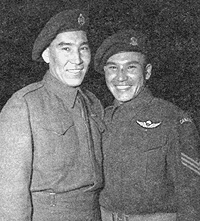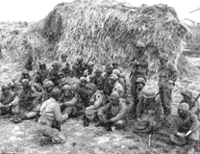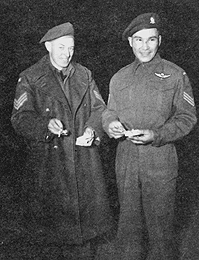Prince of the Brigade

In the Devil's Brigade, Tommy Prince became an expert in reconnaissance. He once posed as a local farmer to repair a severed communications wire—in full view of enemy troops. Here he is shown (right) with a brother at Buckingham Palace, where he was awarded two gallantry medals. (C.J. Woods / Department of National Defence / Library and Archives Canada / PA-142289)
As soon as I put on my uniform I felt a better man.
Thomas George Prince was one of 11 children born to Henry and Arabella Prince of the Brokenhead Band at Scanterbury, Manitoba. He was a descendant of Peguis, the Saulteaux Chief who led his band of 200 Ojibwa from the Sault Ste. Marie region to the Red River in the 1790s, and of Chief William Prince, who headed the Ojibwa-Manitoba team of Nile Voyageurs.
Prince enlisted in June 1940, at the age of 24, and began his wartime service as a sapper with the Royal Canadian Engineers. After two years with the RCE, he answered a call for paratrooper volunteers, and by late 1942, was training with the 1st Canadian Special Service Battalion.
Soon after Prince joined this select battalion, it merged with an elite American unit, forming a spearhead of 1,600 men who possessed an assortment of specialist skills. Officially called the 1st Special Service Force, it would become known to German soldiers as the Devil's Brigade. Originally, this force was intended to be a parachute unit that would land behind enemy lines and sabotage their installations. Instead, it became a versatile assault group with a reputation for specialized reconnaissance and raiding. Prince was well-suited to be a member.
On February 8, 1944, near Littoria, Italy, Reconnaissance Sergeant Prince was spying on the Germans. An abandoned farmhouse some 200 metres from the enemy served as his observation post, and 1,400 metres of telephone wire connected him to the force. He had a clear view of the enemy's artillery emplacements and promptly reported them.

In Italy, a patrol of the Devil's Brigade undergoes a last-minute briefing before setting out. (Lt. Nye / Department of National Defence / Library and Archives Canada / PA-128986)
During what would become a 24-hour solo watch, Prince's communication line was severed by shelling. Unfazed, the sergeant donned civilian clothing, grabbed a hoe and, in full view of German soldiers, acted like a farmer weeding his crops. He slowly inched his way along the line till he found where it was damaged, then, pretending to tie his shoelaces, quickly rejoined the wires. His reporting continued and so did the damage to enemy artillery posts. In all, four German positions were destroyed, and Prince had earned the MM. As his citation explains, "Sergeant Prince's courage and utter disregard for personal safety were an inspiration to his fellows and a marked credit to his unit."
Six months later, the Devil's Brigade entered southern France. On September 1, Sergeant Prince and a private, scouting deep behind German lines near L'Escarène, located the gun sites and encampment area of an enemy reserve battalion. Prince walked 70 kilometres across the rugged, mountainous terrain to report the information and led the brigade to the encampment.69 He then joined in the battle.
Afterward, Prince was recommended for the Silver Star, an American army decoration for gallantry in action.70 His citation was glowing:

Prince (right) with his MM. The sergeant was also awarded the American Silver Star for discovering, and leading the brigade to, an enemy encampment area. (C.J. Woods / Department of National Defence / Library and Archives Canada / PA-142287)
So accurate was the report rendered by the patrol that Sergeant Prince's regiment moved forward on 5 September 1944, occupied new heights and successfully wiped out the enemy bivouac [encampment] area. The keen sense of responsibility and devotion to duty displayed by Sergeant Prince is in keeping with the highest traditions of the military service and reflects great credit upon himself and the Armed Forces of the Allied Nations.
When the fighting in Southern France was over, Prince was summoned to Buckingham Palace, where King George VI decorated him with both the MM and, on behalf of the president of the United States, the Silver Star with ribbon. Tommy Prince was one of 59 Canadians who were awarded the Silver Star during the Second World War.71 Only three of this group also possessed the MM.
In December 1944, the Devil's Brigade was disbanded, and its members were scattered among other battalions. The war in Europe ended while Prince was back in England.
- Date modified: